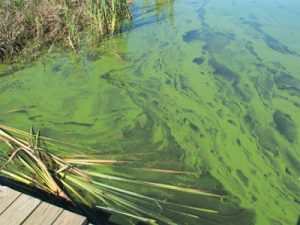How to Control Algae in Rice Crops
Slime is a constant problem in rice crops!
Algae, or slime is a perpetual problem in rice crops in Australia and elsewhere. In some years it is so prevalent in the water that large slabs of algae cover the surface, smothering the emerging rice crop.
| Algae thrives where there are plenty of nutrients in the water and when plentiful sunlight encourages photosynthesis. The usual rice crop conditions of shallow water, fertilizer and sunlight create an ideal environment for the growth of algae. |
During the wet season, the conditions for algae growth are also enhanced as the water from rivers, creeks and reservoirs used on the rice crops, contain a higher level of background nutrients.
Algae is commonly present in irrigation water and generally the rate they multiply is balanced by natural degeneration. However, when the balance is upset through increased sunshine or by the introduction of extra nutrients, the rate of growth increases and the algae blooms become a problem in rice crops.
What are the effects of algae?
The obvious signs of algal bloom – great slabs of algae – are like the tip of an iceberg. Before algae are visually detected a lot of damage has already occurred to the crop at its most vulnerable stage of growth.
These effects include:
Inhibition of seedling germination and vigour – Plant pathologists suggest the possible effect of algae could be greater than that of fungi on germination during early growth of rice seedlings.
Uprooted seedlings – Respiratory and photosynthetic gases become trapped in the filaments tangled around seedlings, uprooting many seedlings which are not yet securely anchored.
Competition for nutrients – Slime lives and grows on the same nutrients as rice seedlings. In a blooming population the sheer numbers of algal cells are enormous and represent a severe drain on the available nutrients.
Seedling knock-down and smother – When filaments of algae are in huge numbers they smother and drown the emerged seedlings and a tremendous amount of damage has already been done. Remedial treatments will salvage the crop but it is obviously better to avoid this damage before it happens. A good seedling stand is essential for high yields.
Present – day treatment
In most cases action to eradicate slime is only taken when filaments are present in huge numbers. And the treatments available are limited. Generally farmers use water control or bluestone, both of which are drastic answers to a problem where a lot of damage has already occurred.
Copper Sulphate (Bluestone)
- Precipitates very quickly – Copper sulphate is precipitated by carbonate hardness, accumulating in sediment at the bottom of the storage and thus rendered unavailable to control algae. In normal water the free copper ions which are toxic to algae combine rapidly with the carbonate ions and fall to the bottom as insoluble copper compounds within an hour. Chelated copper (Coptrol) by comparison is stable in hard water and remains available to be absorbed from the water by algae.
- Is difficult to apply – Bluestone irritates the eyes and skin, is very corrosive to equipment, invasive in aircraft instruments and is hard to spread evenly from the air.
- Is affected by humic content – The greater the humic content in the water, the quicker copper is tied up and precipitated out. Decomposing plant matter in rice crops is thus a major limiting factor in getting results from bluestone. Copper Sulphate also contributes to livestock toxicity problems.
- Because so much copper from bluestone precipitates out rapidly as insoluble carbonates and hydroxides, copper build-up in the soil and pastures is a continuing problem. Already copper toxicity in sheep is well known in the irrigation areas especially if grazing on sub clover, or where Heliotrope or Paterson’s Curse (also known as Salvation Jane, Blueweed, Purple Bluegrass, and Riverina Bluebell) is present.
COPTROL IS THE ANSWER
Coptrol is a new generation algicide which is so safe it is registered for use in human drinking water as well as in rice crops.
Coptrol offers a new approach in the prevention and control of free floating and filamentous algae in rice.
| Coptrol is a special kind of organic compound in which the copper is held so tightly that it cannot be “stolen” by contact with other substances. This means for killing algae much lower quantities of copper are needed when compared with bluestone. Thus preventing copper build-up in pastures. In addition Coptrol is much more effective at killing algae. And far from being irritant and invasive, all the components of Coptrol are specifically exempt from scheduling under the Uniform Poisons Standard of the *NHMRC. *National Health and Medicine Research Council of Australia.
Coptrol is highly specific to algae and does not harm fish, plants or livestock, when used in accordance with label directions. Indeed part of the molecule is a nutrient and algae actively seek out Coptrol, which leads to their quick destruction. |
COPTROL
- is very stable and highly effective in controlling algae
- is a liquid and is easy to apply
- is not corrosive to air craft or equipment remains active in water longer will not build up in the soil

Method of Application
Since Coptrol is a non-corrosive viscous liquid it is extremely adaptable in application. Unlike bluestone, it can be applied as a PREVENTATIVE treatment prior to or immediately after sowing.
It can:
- Piggyback with herbicide and insecticides flown onto aerially sown or drill sown crops
- Be mixed with water and dripped into water flowing into bays
- Be poured from banks directly into flooded bays.
Remedial Treatment
Coptrol can also be used in these ways as a REMEDIAL treatment for green and brown slime (which is usually blue green algae discoloured by degenerating plant material or suspended soil particles).




